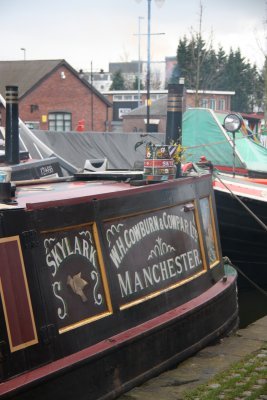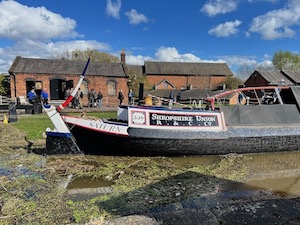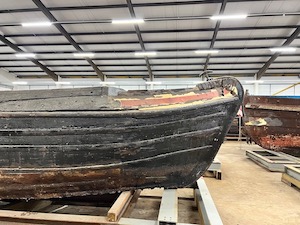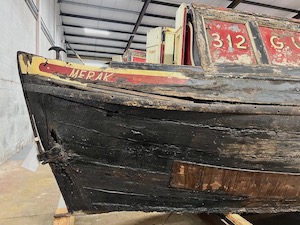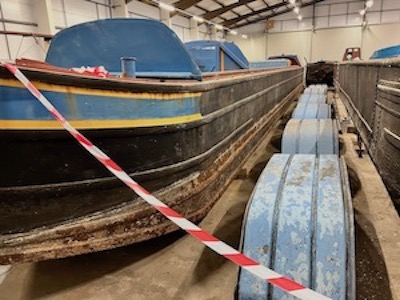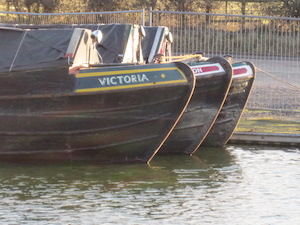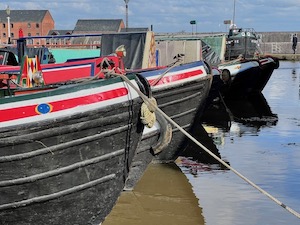< back to Know Your Boats
Introduction to Boat styles
If you are new to historic narrow boats, at first glance they may all look the same (long and thin), but, just as with heavy goods vehicles on the roads, there are subtle variations in design that tell you where and by whom a boat was built. Each style variation has a name – some are the locations of the boatyards, some are the names or nicknames for the carrying companies, some are references to a distinctive feature or fleet/class naming system. The following notes on the larger fleets might help you to start to make sense of it all:
BRITISH TRANSPORT WATERWAYS (BTW) - as well as taking on former FMC and GUCCC boats upon post-war nationalisation, BTW commissioned two new designs in the 1950s/60s – River class (known as Blue tops) for its North West Division, and Admiral class for its South East Division.
FELLOWS MORTON & CLAYTON LTD (FMC) – all their boats are called Joshers, no matter which boat yard built them and which naming class they fall into (eg Fish, Girl, Hill, Overseas, Town, Tree). However, a subset of Joshers is called steamers, built from 1898-1911. All were changed to diesel engines 1915-27 and one has now been restored to steam
GRAND UNION CANAL CARRYING CO LTD (GUCCC) – their boats are categorised after the locations of the three main boat yards where they were built in the 1930s. Woolwiches (small and large) were built by Harland & Wolff Ltd of Woolwich, Northwiches (small, middle and large) were built by W J Yarwood & Sons Ltd of Northwich, and Rickies (small and large) were built by W H Walker & Brothers Ltd of Rickmansworth. The GUCCC boats were put into naming classes: Star class (small and middle boats) and Town class (large boats). In addition, the GUCCC fleet contained the Royalty class boats of its predecessor Associated Canal Carriers Ltd and, from 1932, the Erewash boats of the Erewash Canal Carrying Company Ltd.
All photographs in this section are by R Prettyman, HNBC Web Content Editor, unless otherwise attributed.
|
|
Admiral |
All-steel welded motors & butties built for BTW* (North Division) by Isaac Pimblott & Sons, Northwich and by W J Yarwood & Sons Ltd, Northwich. All were designed to have hooped supports for top cloths rather than the conventional top planks and stands The two Yarwoods pairs, first registered in 1960, have distincitive turned down stemposts as shown in this photo More information/fleet listings here (* BTW - British Transport Waterways) |
||
|
|
The Pimblott boats, built in the late 1950s, have a plainer stempost, as shown in this photo |
|||
|
|
This Yarwoods-built Admiral class butty has two dollies rather than the more usual T-stud of other butties |
|||
|
|
Bantock |
Bantocks built boats, and also operated them as agents, for the Great Western Railway (GWR). Some boats were owned by GWR and some by Bantocks but using a combined fleet numbering scheme. The company also built boats for carriers other than GWR and London Midland & Scottish (LMS). These would effectively be day/joey boats but were built exactly the same as the railway fleet, and had a rather distinctive rounded bow shape Pictured, left, is CENTAUR, currently stored in the Rossfield Road site of National Waterways Museum, Ellesmere Port See also the photo of GWR No 15 More information/fleet listings here
|
||
|
|
Pictured is ELECTRA showing the distinctive Bantock bow shape |
|||
 |
Barlow |
Operated by the Samuel Barlow Coal Company Limited, and S E Barlow, many of their earlier boats were acquired from other carriers but in the 1950s several new boats were commissioned from Nurser Brothers of Braunston and one from W J Yarwood & Sons Ltd, Northwich. All have a distinctive decorative style More information/fleet listings here
|
||
|
|
Cowburn & Cowpar |
1933-36 - eight motors built for W H Cowburn & Cowpar Ltd by W J Yarwoods & Sons Ltd, Northwich; the first two were steel-composite, the remainder were all-steel with rounded chines All these C&C motors were named after birds and carried bird cut outs on the engine room panel. Some of the boats have slightly pointed counters More information/fleet listings here
|
||
|
|
Day boat
|
Open boats used for short journeys Some were completely open, some had rudimentary day cabins with a stove and bench, some were double-ended so that the rudder could be moved instead of having to wind the boat for a return journey. Many were just numbered, so later pleasure craft conversions carry new names More information/fleet listings here
|
||
| |
Erewash boat |
1930s - four iron-composite boats built for the Erewash Canal Carrying Company by W J Yarwood & Sons Ltd, Northwich. Erewash CCC later became part of the Grand Union Canal Co They are one foot shorter than the very similar-looking Northwiches built for GUCCC More information/fleet listings here
|
||
|
|
Fly boat |
Slim boats with fine lines, built for speed and pulled by a relay of horses, housed overnight at bankside stables - the crew worked 24/7 to transport costly and/or perishable goods More information/fleet listings here
|
||
 |
Ice boat |
In horse boating days, ice boats were pulled by a team of horses and crewed by many men standing on the purpose-built platform - the boat was pulled onto the ice and vigorously rocked from side to side Later, some motor boats were shortened and fitted with an ice-breaking ram at the fore end eg TYCHO (originally a full length middle Northwich) More information/fleet listings here |
||
|
Inspection launch |
||||
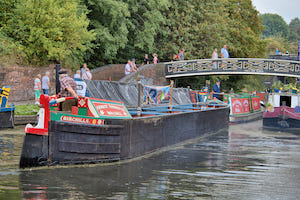 |
Joey |
Joey boats were wooden and originally got their name from wooden boat builder Joseph Worsey from Toll End, Tipton, and were referred to as ' one uv Joeys' Pictured is Birchills (photo by K Maslin) More information/boat listings here |
||
|
|
Josher |
Named after Joshua Fellows, one of the founders of Fellows, Morton & Clayton Ltd (incorporated 1889). A very large fleet of narrow boats built by FMC at their own yards at Saltley and Uxbridge and also by W J Yarwood & Sons Ltd, plus smaller numbers at other independent boat yards From wooden horse boats in the early days, to steamers in the 1880s, then motors and butties from early 1900s onwards - all are identifiable by their elegant, sweeping fore ends and semi-circular counters with three guards and two counter bands on metal motors, and four guards on wooden motors FMC fleet listings here |
||
 |
Knobstick |
Wooden boats, many built at its Middleport yard by the Anderton Company, for the potteries trade on the northern Trent & Mersey canal |
||
|
|
Northwich
|
1930s iron-composite/steel-composite/steel motors & butties built for Grand Union CCC by W J Yarwood & Sons Ltd, Northwich The Star class have shallower holds at 4ft 2ins (known as small Northwiches); the Town class have deeper holds at 4ft 9 1/2ins (known as big Northwiches); between the two sizes are the middle Northwiches (also Star class) which have holds of 4ft 6ins and rounded chines which causes them to roll - some were later converted to ice boats and tugs All have stemposts with a curved turnover onto the deck, have counters with four guards and three counter bands and are elliptical rather than semi-circular GUCCC fleet listings here [Photos: Kathryn Dodington] |
||
|
|
Ricky |
1935-38, wooden motors & butties built for GUCCC by W H Walker & Brothers Ltd, Rickmansworth The photos, left, show the fore end and stern of the remains of wooden Ricky boats Merope and Merak in the Rossfield Road storage site of the National Waterways Museum, and are a graphic illustration of the vulnerability of wooden boats Another example here
|
||
|
|
River class Blue tops |
1959-60 steel butties & two motors built for BTW* (Southern Division) by E C Jones & Sons (Brentford) Ltd and by Thames Launch Works Ltd. The two motors were Anne and Lee, but the butties were mostly named after three-letter rivers eg Dee, Exe, Wye All were designed to have fibre-glass blue tops to cover the cargo rather than the conventional cloths with top planks and stands More information/fleet listings here (* BTW - British Transport Waterways) |
||
|
|
Royalty class |
1931-32 coppered steel motors and wooden butties built for Associated Canal Carriers Ltd, which became GUCCC The two steel prototypes, George & Mary, were built in 1929 by the Steel Barrel Co Ltd, Uxbridge. The later coppered steel boats were built by W J Yarwood & Sons Ltd, Northwich and by James Pollock & Sons Co Ltd, Faversham Deep hulled boats capable of carrying large cargoes, fast on rivers and deep water GUCCC fleet listings here |
||
 |
Severner |
1920s built by Charles Hill & Sons Ltd, Bristol, for Severn & Canal Carrying Co Ltd for trade between Gloucester and Birmingham More information/fleet listings here |
||
 |
Tug |
Some were purpose-built, others converted and shortened from existing full length narrow boats More information/fleet listings here
|
||
|
|
Woolwich |
1935-38 iron-composite, steel or steel-composite motors & butties built for Grand Union CCC by Harland & Wolff Ltd, Woolwich The Star class boats have shallower holds at 4ft 2ins (known as small Woolwiches); the Town class have deeper holds at 4ft 9 1/2ins (known as big Woolwiches) Their stemposts do not have the exagerated turnover curve of a Northwich-built boat The counter has three guards and two counter bands GUCCC fleet listings here |







